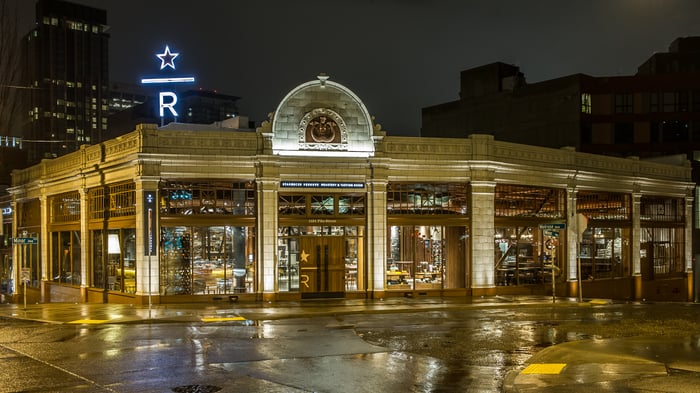Earlier this week, Starbucks (SBUX 0.53%) opened its second Starbucks Reserve Roastery. The pilot location opened in Starbucks' hometown of Seattle three years ago. Fittingly, the second Roastery is in Shanghai, the city with more Starbucks cafes (in excess of 600) than any other.
The opening of the Shanghai Roastery is one of the first tangible steps in a multiyear plan to move Starbucks further upmarket and bolster its brand. Success in this effort could determine whether Starbucks can continue to grow earnings per share at a double-digit rate over the next five to 10 years.
Starbucks doubles down on the Roastery concept
The first Starbucks Reserve Roastery in Seattle has performed extremely well thus far. At the company's investor day last year, Starbucks revealed that the average transaction price for the Seattle Roastery is four times the company average. Starbucks may be able to grow that further after it added fresh food from popular Italian bakery Princi to the Roastery menu last month.

The first Starbucks Reserve Roastery has been a huge success. Image source: Starbucks.
Like the Seattle Roastery, the new Shanghai location will feature super-premium coffee that is roasted on site and brewed to order, along with fresh-baked food from Princi. It will also offer an innovative tea bar (in a nod to China's tea culture) and an augmented reality experience to entertain customers while they are waiting.
While it took Starbucks three years to open its second Roastery, the pace of expansion is set to accelerate dramatically going forward. It already plans to open three more Roasteries across the world next year, located in Milan, New York, and Tokyo. A sixth Starbucks Reserve Roastery is slated to open in Chicago in 2019.
Building a new ecosystem
Starbucks certainly hopes that its new Roasteries are just as popular with customers as the Seattle location. However, they will also serve a greater strategic purpose for the company.

The second Starbucks Reserve Roastery opened last week. Image source: Starbucks.
First, the coffee they roast on site will be distributed regionally to special Starbucks Reserve cafes and a portion of the regular Starbucks store base. Starbucks plans to open at least 1,000 dedicated Starbucks Reserve stores, which will only serve premium coffees from the network of Roasteries. They will also feature fresh-baked food from Princi. Additionally, thousands of existing Starbucks cafes will get Reserve coffee bars to go along with the regular Starbucks offerings.
Second, the Starbucks Reserve Roasteries will showcase the best of Starbucks, with the goal of further elevating the brand. While many people already think of Starbucks as being expensive, you can walk into most locations today and buy a regular coffee for about $2 plus tax.
By contrast, the starting price for a cup of coffee is about twice that much at a Starbucks Reserve cafe. In some cases, the drinks there could cost $10-$12 a cup. Ultimately, for the Reserve concept to meet Starbucks' lofty goals, the company will need to convince millions of people to spend billions of dollars a year on such pricey coffee drinks. People who experience one of the Roasteries will be more likely to become regular Starbucks Reserve customers.
Paving the way for future sales growth
After an amazing run of growth following the Great Recession, Starbucks' comp sales growth has been slowing recently, particularly in the U.S. As a result, the stock has barely budged over the past two-and-a-half years.
The sales slowdown can be attributed in part to some stores' difficulty in coping with the rising tide of mobile orders. Nevertheless, Starbucks' current malaise (if you can call it that) extends beyond short-term operational issues. The company reduced its long-term EPS growth guidance last month, although it still expects healthy annual increases of at least 12%.
Thus, Starbucks may need a jolt to help it get back to a faster growth pace. Starbucks Reserve could be that jolt by bringing in new customers and getting existing customers to spend more. That will be especially important in the most saturated U.S. markets. The growing network of Starbucks Reserve Roasteries is the linchpin of this strategy -- both because they will provide the coffee and because they can help convince customers that it's worth spending even more money for a cup of joe.





